Harlequin sign - Study guides, Class notes & Summaries
Looking for the best study guides, study notes and summaries about Harlequin sign? On this page you'll find 77 study documents about Harlequin sign.
Page 3 out of 77 results
Sort by
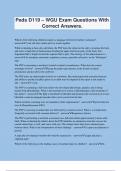
-
Peds D119 – WGU Exam Questions With Correct Answers.
- Exam (elaborations) • 41 pages • 2024
-
- $13.49
- + learn more
Peds D119 – WGU Exam Questions With Correct Answers. Which of the following children requires a language referral for further evaluation? - answer2 year old who cannot put two words together While evaluating a three-day-old infant, the FNP turns the infant on the side to examine the back and notes a sharp line of demarcation dividing the upper and lower parts of the body. The dependent half is bright red and the superior half is pale. The etiology of this phenomenon is: - answerAn immat...

-
NR 509 Final
- Exam (elaborations) • 24 pages • 2024
-
- $16.79
- + learn more
NR 509 Final Childhood immunizations Birth- Hep B, Flu 1-2 mos- DTap, Hep B(2), HIB, Polio, Pneumococcal, Rotavirus 3-4 mos- DTap (2), HIB (2), Polio (2), Pneumo (2), Rotavirus (2) 5-6 mos- Dtap (3), HIB (3), polio (3), pneumo (3), Rotavirus (3), Flu 7-11 mos- flu 12-23 mos- Varicella, DTap (4), HIB (4), MMR (1), Polio (3), Pnuemo (4), Hep A, Hep B (3), Flu 2-3 years- Flu 4-6 years- DTap (5), Polio (4), MMR (2), Varicella (2), Flu 7-10 years- Flu, HPV 11-12 years- Mening, HPV (2), T...
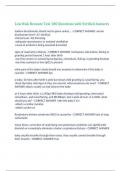
-
Low Risk Neonate Test 180 Questions with Verified Answers,100% CORRECT
- Exam (elaborations) • 20 pages • 2024
-
- $12.99
- + learn more
Low Risk Neonate Test 180 Questions with Verified Answers Sodium bicarbonate should not be given unless... - CORRECT ANSWER -serum bicarbonate level <15-16mEq/L -PaCo2 level <40-45mmHg -adequate spontaneous or assisted ventilation -cause of acidosis is being assessed & treated signs of respiratory distress - CORRECT ANSWER -tachypnea, retractions, flaring or grunting persist beyond 1 hour after birth -any time severe or worsening tachypnea, retractions, flaring, or grunting devel...
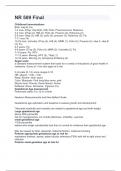
-
NR 509 Final
- Exam (elaborations) • 24 pages • 2024
-
- $14.49
- + learn more
NR 509 Final Childhood immunizations Birth- Hep B, Flu 1-2 mos- DTap, Hep B(2), HIB, Polio, Pneumococcal, Rotavirus 3-4 mos- DTap (2), HIB (2), Polio (2), Pneumo (2), Rotavirus (2) 5-6 mos- Dtap (3), HIB (3), polio (3), pneumo (3), Rotavirus (3), Flu 7-11 mos- flu 12-23 mos- Varicella, DTap (4), HIB (4), MMR (1), Polio (3), Pnuemo (4), Hep A, Hep B (3), Flu 2-3 years- Flu 4-6 years- DTap (5), Polio (4), MMR (2), Varicella (2), Flu 7-10 years- Flu, HPV 11-12 years- Mening, HPV (2), T...
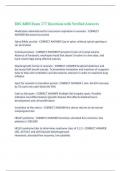
-
RNC-MNN Exam 177 Questions with Verified Answers,100% CORRECT
- Exam (elaborations) • 19 pages • 2024
-
- $12.99
- + learn more
RNC-MNN Exam 177 Questions with Verified Answers Medication administered for meconium aspiration in neonate - CORRECT ANSWER Beractant (survanta) Spina Bifida occulta - CORRECT ANSWER Gap in spine, without spinal opening or sac protrusion Craniosynostosis - CORRECT ANSWER Premature fusion of cranial sutures. Absence of fontanels, misshapen head that doesn't resolve in a few days, and hard raised ridge along affected sutures. Diaphragmatic hernia in neonate - CORRECT ANSWER Scaphoid ...
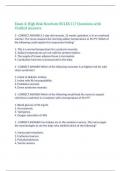
-
Exam 4: High Risk Newborn NCLEX 117 Questions with Verified Answers,100% CORRECT
- Exam (elaborations) • 30 pages • 2024
-
- $11.49
- + learn more
Exam 4: High Risk Newborn NCLEX 117 Questions with Verified Answers 3 - CORRECT ANSWER A 1-day-old neonate, 32 weeks' gestation, is in an overhead warmer. The nurse assesses the morning axillary temperature as 96.9°F. Which of the following could explain this assessment finding? 1. This is a normal temperature for a preterm neonate. 2. Axillary temperatures are not valid for preterm babies. 3. The supply of brown adipose tissue is incomplete. 4. Conduction heat loss is pronounced ...
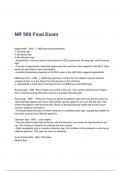
-
NR 509 Final Exam
- Exam (elaborations) • 21 pages • 2024
-
- $15.99
- + learn more
NR 509 Final Exam Appendicitis - ANS 1. McBurney point tenderness 2. Rovsing sign 3. the psoas sign 4. the obturator sign --Appendicitis is twice as likely in the presence of RLQ tenderness, Rovsing sign, and the psoas sign --The pain of appendicitis classically begins near the umbilicus, then migrates to the RLQ. Older adults are less likely to report this pattern. --Localized tenderness anywhere in the RLQ, even in the right flank, suggests appendicitis. McBurney Point - ANS...
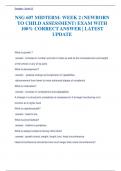
-
NSG 607 MIDTERM- WEEK 2 (NEWBORN TO CHILD ASSESSMENT) EXAM WITH 100% CORRECT ANSWER | LATEST UPDATE
- Exam (elaborations) • 8 pages • 2024
-
- $9.99
- + learn more
What is growth ? answer: increase in number and size of cells as well as the increased size and weight of the whole or any of its parts What is development? answer: -gradual change and expansion in capabilities -advancement from lower to more advanced stages of complexity What is maturation? answer: increase in competence and adaptability. A change in a structure's complexity is necessary for it to begin functioning or to function at a higher level What is cephalocaudal? answer: h...
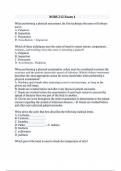
-
NURS 212 Exam 1
- Exam (elaborations) • 47 pages • 2024
- Available in package deal
-
- $13.00
- + learn more
When performing a physical assessment, the first technique the nurse will always use is: A. Palpation. B. Inspection. C. Percussion. D. Auscultation. - Inspection Which of these techniques uses the sense of touch to assess texture, temperature, moisture, and swelling when the nurse is assessing a patient? A. Palpation B. Inspection C. Percussion D. Auscultation - Palpation When performing a physical examination, safety must be considered to protect the examiner and the patient again...
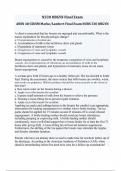
-
N330 OBGYN Final Exam - ABSN 40 CSUSM Marko
- Exam (elaborations) • 48 pages • 2024
-
- $15.00
- + learn more
A client is concerned that her breasts are engorged and uncomfortable. What is the nurses explanation for this physiologic change? a. Overproduction of colostrum b. Accumulation of milk in the lactiferous ducts and glands c. Hyperplasia of mammary tissue d. Congestion of veins and lymphatic vessels d. Congestion of veins and lymphatic vessels Breast engorgement is caused by the temporary congestion of veins and lymphatic vessels. An overproduction of colostrum, an accumulation of milk in...

That summary you just bought made someone very happy. Also get paid weekly? Sell your study resources on Stuvia! Discover all about earning on Stuvia


